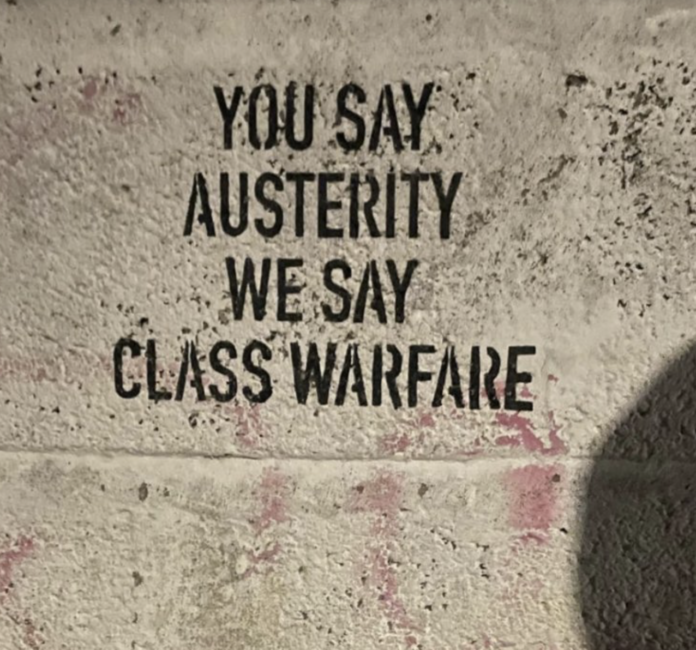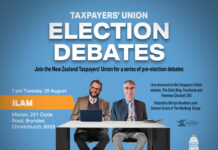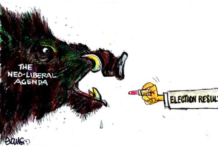Demand and supply are described by neo-liberal market economists as the forces in the economy that work together to set the market price for a product. And that price will ensure the efficient allocation of scarce resources. Because if something is not desired at a certain price then production will be cut back so resources are not wasted on producing more of it. If there is a big demand for something at a high price then more resources will be directed to producing it because of profits. And that is an efficient use of resources because people want it. The increased supply will also mean the price will be lower as more demand is satisfied.
This is at its most basic but this is the level that demand and supply is currently pitched to ordinary people through media analysis and commentaries on so many issues, e.g. housing. The more houses that are built the cheaper housing will be. Yeah right.
And most people have been indoctrinated to believe it. And they are inclined to believe it, because it seems to match their experience and attitude when buying things. If something is new and nice they think I’ll get it now in case it runs out so I’ll pay a high price now rather than wait for a sale. Potential scarcity can drive their decision.
The problem is – this is their perception on the demand side of the equation, driven by scarcity in this case. But that decision could just as easily be (if it’s clothing) ‘because it makes me look nice’, or (food) ‘I’m hungry’. Supply has nothing to do with it. Need is often the driver, sometimes want. Sometimes price is the decider the red one for $x or the black for$X.
Whenever you go to purchase, unless it is second hand, there is always plenty of supply. But let me be clear it is a lie to say supply (the volume) is interacting with demand to determine the price for almost all transactions.
Some economists will be outraged at these examples because demand and supply is all done by aggregate. But that is my exact point, my examples show the lie in how demand and supply is understood by people (and the understanding is not accurate to the theory) and that misunderstanding is misused by politicians. And for housing is used by developers to justify things like aggressive housing policies that trash local democracy, just so developers can maximise their profit, and not provide affordable housing*.
But here is the second demand and supply lie – when you aggregate the demand and supply data you have a huge timing difference between when decisions about how much to supply and when actual sales are made. The two dimensional ‘demand and supply diagram’ implies the interactions are largely contemporaneous. But as they are separated by time and aggregation, which loses the reason for purchase, therefore demand and supply is not causal by themselves
Yes previous sales data will give good predictive qualities for the volume of next years sales and when to bring the sales on. But this is supported by how much advertising and market research they have to spend to get those sales. But there are always variables, like a recession, that can upset predictions.
These extra facts, timing discrepancies, marketing, advertising, upsets; are the fatal flaws in the demand and supply diagram as a description of how the market works to set prices – to accumulate wealth for a business.
The whole concept of demand and supply would be such a laughable joke – that intelligent adults believed this and put it in books – if the consequences of this belief weren’t so serious for the planet. For example in the text book ‘Economics’ By Joseph E. Stiglitz and Carl E. Walsh (international student edition 2006 p59) A photo of an SUV is captioned with ‘Low Gas prices in 1990’s and early 2000’s led to higher demand for SUVs.’
Bullshit. What was the need? Cities are designed for individual motorised transport, (until cities change) that is the need. There are big car companies. It was hard competing with small better fuel efficient Japanese cars (whose companies have experience of a large population in a small area) . Companies pivot to points of difference – large country – military experience in recent wars – outback interests – safety on roads. They market research it could work. To maximise profit they set high prices and made sure lucrative debt financing arrangements were available at the point of sale, that they can have as their main income stream. They produce and aggressively market/advertise along the above points and US nationalist lines.
People are manipulated well away from their true core need and into thinking their core need is something more emotional. And despite rises in gas prices people still want to drive them. No efficiency in resource build or use of the vehicle, no social or environmental respect in ownership.
These intelligent economists know this but they do not abandon the simplistic and deceiving demand and supply concept and diagram. Because they have data that shows size of vehicle sold seems to match the relative changes in the price of a complementary good oil/gasoline. i.e. low oil prices associates with an increase of large car sales.
If this is the cause of the dangerous SUV that is significantly contributing to the climate crisis then the obvious solution is to jack up gas prices as much as possible so consumers don’t buy big cars. Punish the demand side of the economy by pushing them into poverty. To preserve ‘freedom’ do nothing about the businesses, the supply side of the economy, that is wasting the worlds scarce resources by pushing these environmentally damaging vehicles onto people.
These are the sort of solutions the impersonal mechanical demand and supply diagrams suggest because they are the only causes the diagram suggests. Yes there is some data to suggest the complimentary price impacted the sales but because it over simplifies and overstates a cause, price, the economist can’t come up with a proper solution. The world is very different now as we know so much more about peoples fragilities and how to manipulate them through marketing and advertising.
The reality for large companies is that price is set by a sophisticated mix of psychological manipulation and misinformation. Demand is met by a fragmentation of supply (from the core customer need e.g. individual motorised transport) with huge numbers of variations to create illusions of choice which are chosen to create feelings of desire and scarcity in a consumer, so the consumer will pay more to get that slight variation.
The pricing process within our current private market led economy is also damaging the ability of the economy to adapt to climate change. We see this most easily in the pricing of electric vehicles. Because they are popular businesses use that knowledge to push up the price. making them harder to get so they do not spread through the economy as quickly. I accept there is not an unlimited ability to supply electric vehicles; but rather than have some expensive examples sitting on shop floors it would be better to have them on the road by lowering prices.
And high prices for electric vehicles encourages the supply of more luxury end electric vehicles. But more basic smaller and cheaper electric vehicles with more volume sold would be better for society and the environment. Prices are sending the wrongs signals for what the economy needs. This is a common problem and slows all sorts of change especially around technology adoption.
The pricing process on the supply side of the economy is the modern problem. The process needs to have better incentives and constraints so that scarce resources are not over used and the right signals are sent for moving quickly to a sustainable economy.





I guess we gloss over the fact cheap means unsustainable a lot of the time from it’s origin of labour, resources, reliability and environmental impact. I guess we won’t mention this in supply and demand.
For example TWG sell office furniture that contributes an estimated 90 tons of poisoning landfill a month – and that stat is 7 years old.
There are other impacts to supply and demand we must think about.
Eg: Housing NZ built houses lifting off piles which just should not happen even in minor flooding in Māngere.
Do you want or do we need money to have a 2 year warrantee or a 10 – 15 year guarantee on goods & services?
False economy on cheap quality is killing NZ environmentally and most likely globally from point of origin.
Yes, Rogue Estate, the old but all too familiar manufacturing model of take, make and waste. Economic theory has a lot to answer for.
Hi Rogue Estate, cheap is a real problem. Totally agree. But that is ‘cheap’ in a private market maximise profit regime. Home grown veggies are cheap in a good way. So I agree with your examples
While I accept that you have made many valid points I feel that the main issue is that the economy is a lot more complicated than people like David Seymour can understand.
You do see supply & demand at work in the local supermarket where the product is close to its best-before date or produce needs to be sold quickly although I guess selfish desire by the supermarket to maximise their profit with no concern about selling a possibly inferior product also explains their actions.
Hi Bonnie, Supermarkets aren’t great at demand and supply. They do drop the price on a few things before best by date but generally they dumped it. They give a lot more away now but that is not demand and supply doing that. They still get insurance and tax deductions for loss on disposal.
At the “wholesale” level fresh fruit and vegetables are sold by auction at firms such as (in Wellington) Turners & Growers and Market Gardeners. Buyers will adjust the prices they are prepared to pay in accordance with quantities they see on the floor, and growers, at the time of planting, will base their planting decisions on what they think will fetch high prices after harvesting; though I think some growers do have supply deals with the supermarkets.
The more I read your articles, the more I feel that your biggest problem is people having independence and individuality with power of thoughts, wants and needs.
What you are drifting towards in your conclusions is that the people will own nothing and be happy. They will be ruled, manipulated, coerced, constricted and confined to the dictates of the PMC. After all the PMC (or pigs walking on two legs as per Orwell’s book) knows best. Individuality is not to be tolerated. Where do you fit in Mr Minto? Two legs or four?
The PMC will be staffed no doubt by the Stephen Minto types, full of righteously thoughts and rules to gloat over the masses from their secure high rises to look down on the minions with total control.
Maybe in your next article you can cover the demand for better education? Or would that better education make the four legged animals want to walk on two legs and become a rival PMC? Hence we dumb down education?
Hi Gerrit, You have created a straw man about me not liking ‘independence and individuality’. Once you have that daft idea you can say anything and pretend to be clever. Can you hear the advertisers and marketeers mocking you when you watch the ads?
Most/many economists are highly critical of demand and supply as a conceptual framework to understand the economy. I just think it still dominates our commentary and I’m pointing out it is rubbish. If you want to get educated – a great book is ‘Doughnut Economics’ by Kate Raworth
I don’t see how you conclude that Stephen does not want people having independence and individuality with power of thoughts, wants and needs? The problem with society is that wealth is able to restrict the options for those without wealth while they often do not pay the cost to society of whatever economic activity they are involved in. History would suggest that when the wealth divide is vast & the overwhelming majority of people consider themselves poor, big changes can happen so we will wait & see what happens next. Having a decent leader with integrity is essential for real change & they don’t seem to exist anymore so I expect the future to be messy.
Google images show supply/demand lines as straight lines (& parallel lines) taken from textbooks. There is no evidence for straight lines nor the intersections with the axes. The SMD theory shows that it is not valid to combine single demand curves (or lines) into a combined downward sloping plot. The idea that changing circumstances produce a parallel shift in demand (& supply) has no basis in evidence. This assumption is economists being ridiculous.
The supply curves (lines) portrayed as upward sloping lines is false. Producers as found by an important economist, Alan Binder, face lowering costs with higher production, yet his textbook continued to portray the fantasies of generations of economists who cling to an ideology.
Goods have different nature which affect consumption. Necessities of life are different to goods that provide ‘utility’ and different from ego goods to make the poor feel inferior.
The equilibrium of the intersection of supply/demand lines at a point in time is not the way to think about it. The rate of goods produced minus the rate of goods sold equals the rate of inventory increase. It should be all about dynamics not equilibrium.
“The world is very different now as we know so much more about peoples fragilities and how to manipulate them through marketing and advertising….The reality for large companies is that price is set by a sophisticated mix of psychological manipulation and misinformation”.
Now, ain’t that the truth.
It doesn’t take a big step to rephrase this as:
The world is very different now as we know so much more about peoples fragilities and how to manipulate them through public relations and political spin….The reality of politics in the post-modern world is that political allegiances, for many, are shaped from a sophisticated mix of psychological manipulation and misinformation.
But I suspect there’s always been some truth to this assertion.
Hi Bozo, yes I agree propaganda has been around for a long time and people with money can afford the most research and then use manipulation to associate positive ideas to the outcome they want. However, people presenting ideas directly is a part of free speech. I was just limiting my discussion to economics which is full of lies and manipulation, to create demand. e.g. tough strong independent men like the Marlborough man smoke cigarettes. Until they die wasted away in a hospital bed with cancer.
Don’t often agree with you Gerrit, but you are entirely correct on this. The PMC know better than the lower animals and have the ‘correct’ values.
HI Ada, What’s is the PMC? Never mind. Read my reply to Gerrit.